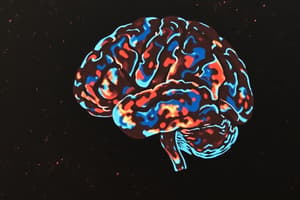Podcast
Questions and Answers
Who was Hippocrates?
Who was Hippocrates?
- A mathematician
- A Greek physician (correct)
- A Roman general
- A Greek philosopher
What are neurons?
What are neurons?
A nerve cell; the basic building block of the nervous system.
How many nerve cells are contained in the brain?
How many nerve cells are contained in the brain?
100 billion
What are synapses?
What are synapses?
How many synapses are contained in the brain?
How many synapses are contained in the brain?
What is the central nervous system (CNS)?
What is the central nervous system (CNS)?
What does the peripheral nervous system (PNS) consist of?
What does the peripheral nervous system (PNS) consist of?
What are nerves?
What are nerves?
What are the three types of neurons?
What are the three types of neurons?
What do sensory neurons do?
What do sensory neurons do?
What do motor neurons do?
What do motor neurons do?
What are interneurons?
What are interneurons?
What is the cell body of a neuron?
What is the cell body of a neuron?
What are dendrites?
What are dendrites?
What are axons?
What are axons?
How long can the longest axon in the human body be?
How long can the longest axon in the human body be?
What is the axon terminal?
What is the axon terminal?
What is the myelin sheath?
What is the myelin sheath?
What is action potential?
What is action potential?
What is the cell membrane?
What is the cell membrane?
What is intracellular fluid?
What is intracellular fluid?
What is extracellular fluid?
What is extracellular fluid?
What are soluble protein molecules?
What are soluble protein molecules?
What are potassium ions?
What are potassium ions?
What are sodium ions and chloride ions?
What are sodium ions and chloride ions?
What is resting potential?
What is resting potential?
What is the depolarization phase?
What is the depolarization phase?
What is the repolarization phase?
What is the repolarization phase?
Study Notes
Hippocrates and the Brain
- Hippocrates was a Greek physician known for observing the link between head injuries and changes in thoughts and actions, prompting a focus on the brain in medicine.
Neurons and Nervous System
- Neurons are the fundamental units of the nervous system, acting as nerve cells that transmit signals.
- The human brain contains approximately 100 billion neurons.
- The brain features around 100 trillion synapses, which are essential communication points between neurons.
Nervous System Structure
- The central nervous system (CNS) comprises the brain and spinal cord, coordinating most activities of the body.
- The peripheral nervous system (PNS) consists of nerves branching from the CNS to connect with sensory organs, muscles, and glands.
Types of Neurons
- There are three main classes of neurons: sensory neurons, motor neurons, and interneurons.
- Sensory neurons transmit information from sensory organs (e.g., eyes, ears) into the CNS.
- Motor neurons convey information from the CNS to muscles and glands for action.
- Interneurons, found only within the CNS, facilitate communication between neurons and play critical roles in reflexes and complex behaviors.
Neuron Structure
- The cell body is the neuron’s main part, housing the nucleus and vital cellular machinery.
- Dendrites are branch-like structures that receive signals from other neurons, with motor and interneuron dendrites closely connected to the cell body.
- Axons are long, slender projections that send messages away from the cell body to other neurons or muscle cells.
- The longest human axon spans about 5 feet, stretching from the toe to the brain.
Neuronal Communication
- The axon terminal is where neurotransmitters are released to convey messages between neurons.
- The myelin sheath covers many neuron fibers, enhancing the speed of neural impulse transmission through node hopping.
Action Potential
- Action potential refers to the electrical signals traveling along an axon, capable of firing at rates up to 1,000 times per second.
- This signal initiates movement across the cell membrane, aided by the cell’s membrane, which selectively allows substances to enter and exit.
Cellular Composition
- Intracellular fluid, or cytoplasm, is the liquid inside the cell, while extracellular fluid surrounds it.
- Soluble protein molecules carry negative charges, primarily found in the intracellular environment, influencing ionic balance.
- Potassium ions (K+) are mainly located inside the cell, while sodium ions (Na+) and chloride ions (Cl-) are more concentrated outside.
Neuronal States
- Resting potential describes a neuron's baseline state, marked by a slight negative charge when inactive.
- During the depolarization phase, sodium ions rush into the neuron, temporarily inverting the electrical charge across the membrane.
- The repolarization phase occurs as potassium ions exit the cell, restoring the resting potential.
Studying That Suits You
Use AI to generate personalized quizzes and flashcards to suit your learning preferences.
Description
Test your knowledge with these flashcards from Chapter 5 of Peter Gray's Psychology. This chapter focuses on the biological bases of behavior, discussing key concepts such as neurons, synapses, and the impact of head injuries. Perfect for students looking to reinforce their understanding of neuroscience in psychology.




